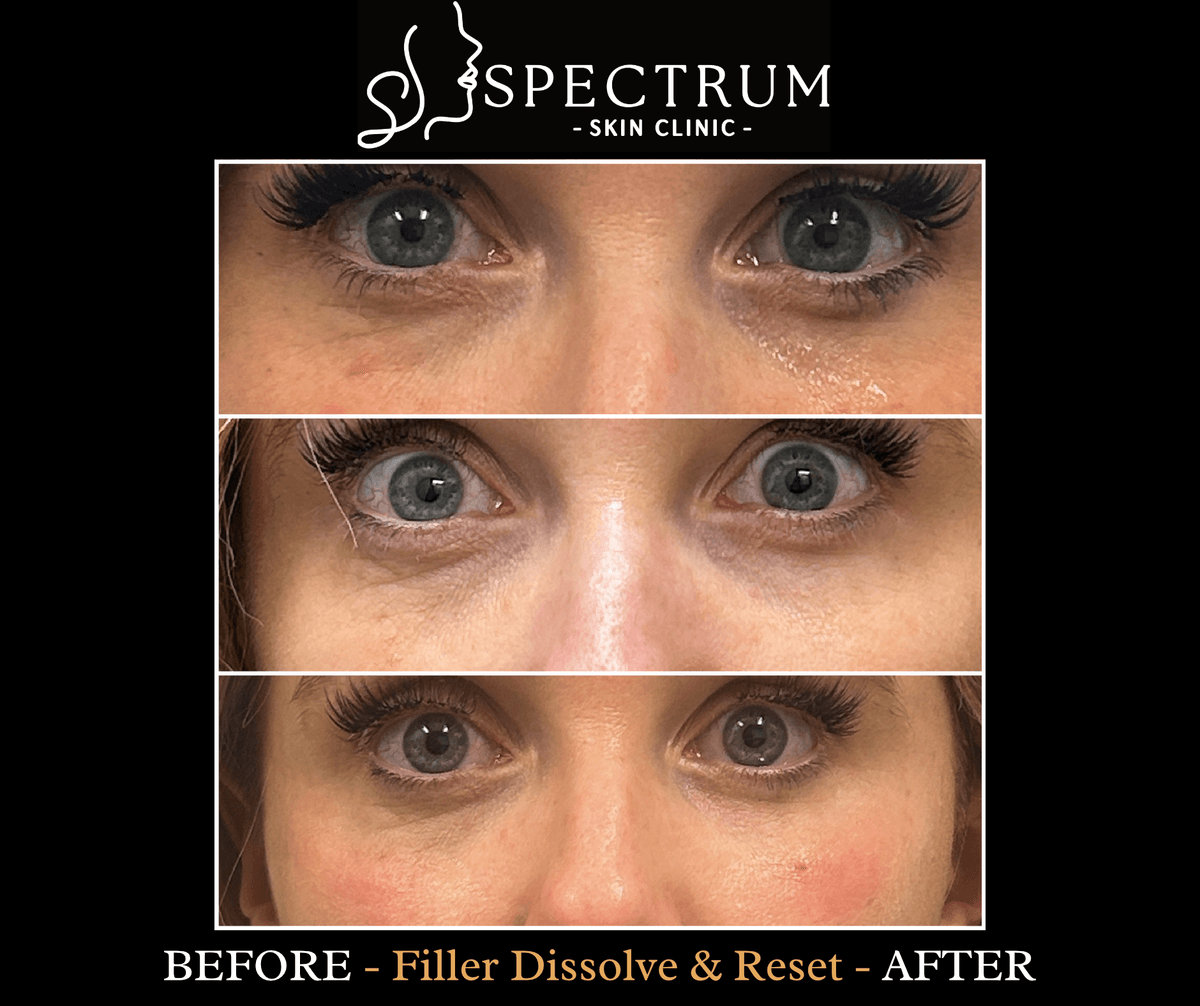Filler Dissolve & Reset: Correcting Under-Eye Filler Gone Wrong
Under-eye filler can be transformative when done correctly, but when it goes wrong, the results can be frustrating and even embarrassing. Swelling that won't resolve, a bluish tinge under the skin, or that telltale puffiness that makes you look more tired than before treatment—these are signs your filler needs to be dissolved and redone properly.
At Spectrum Skin Clinic, we regularly see patients who received under-eye filler elsewhere and are dealing with complications. The good news is that hyaluronic acid fillers can be reversed, and when replaced strategically, the under-eye area can look refreshed and natural. This process is called a filler dissolve and reset, and it's one of the most satisfying corrections we perform.
When Under-Eye Filler Needs to Be Dissolved
Not all filler complications are the same, but certain issues signal it's time to dissolve and start over. The most common problems we see include persistent swelling that doesn't improve weeks or months after injection, a condition known as the Tyndall effect where filler placed too superficially creates a bluish or grayish discoloration under the skin, and migration where the filler moves from its original placement, creating puffiness or an unnatural contour.
Some patients also experience what's called a halo effect, where the skin around the filler takes on a blushing or reddish tinge due to vascular congestion or inflammation. In other cases, the filler was simply placed incorrectly from the start, either too much product was used, it was injected in the wrong plane, or the technique didn't account for the patient's natural anatomy.
If you're dealing with any of these issues, attempting to wait it out rarely helps. Hyaluronic acid fillers like Restylane can last 12 to 18 months or longer in the under-eye area, which means you could be living with an unflattering result for over a year if you don't take action.
How Filler Dissolve Works
The process of dissolving unwanted filler is straightforward and typically takes just minutes. We use an enzyme called hyaluronidase, which specifically breaks down hyaluronic acid—the substance that makes up most dermal fillers. When injected into the area where filler sits, hyaluronidase begins working immediately to dissolve the product.
The enzyme is injected directly into the problematic areas using a fine needle. You may feel a slight pinch during injection, but the discomfort is minimal and brief. Within minutes to hours, the filler starts to break down. Most patients notice visible improvement within 24 to 48 hours, though it can take up to a week for the enzyme to fully dissolve all the product.
After the filler is dissolved, the under-eye area returns to its baseline appearance. This gives us a clean slate to work with when we perform the reset. Some mild swelling or tenderness is normal for a few days after hyaluronidase treatment, but this resolves quickly and is far less bothersome than living with poorly placed filler.
The Reset: Doing It Right the Second Time
Once the old filler has been dissolved, we wait three to four weeks before performing the reset. This waiting period is essential because it allows any residual swelling to resolve completely and gives us an accurate view of your natural anatomy. Rushing into re-treatment before the tissue has settled can lead to overcorrection or repeating the same mistakes.
When it's time for the reset, Dr. Munib uses Restylane to carefully address the under-eye hollows and dark circles. The technique matters just as much as the product. Filler must be placed in the correct tissue plane—deep enough to avoid the Tyndall effect but strategic enough to provide support and volume where it's needed. We use small amounts of product and inject conservatively, building volume gradually rather than overfilling in one session.
The goal is to create a smooth transition from the lower eyelid to the cheek, softening the shadow caused by volume loss without creating puffiness or an unnatural appearance. Restylane is particularly well-suited for this area because it integrates smoothly into the tissue and provides long-lasting support without excessive swelling.
What to Expect During the Dissolve and Reset Process
The timeline for a filler dissolve and reset typically spans four to six weeks from start to finish. During your initial consultation, Dr. Munib will assess the current filler placement and determine whether dissolving is necessary. If you move forward with the dissolve, you'll see the problematic filler begin to break down within the first few days.
The middle phase—those three to four weeks between dissolving and resetting—allows your under-eye area to return to baseline. Some patients feel self-conscious during this period because the hollows or dark circles they originally sought to correct are visible again. This is temporary and necessary for achieving the best possible outcome with the reset.
When you return for the reset appointment, the new filler is placed with precision. You may notice immediate improvement, though optimal results develop over the following week as any minor swelling from the injection subsides. The results from properly placed under-eye filler typically last 12 to 18 months, though this varies based on individual metabolism and lifestyle factors.
Who Benefits from a Filler Dissolve and Reset
his treatment is ideal for patients who received under-eye filler elsewhere and are unhappy with the results. If you're dealing with persistent puffiness, discoloration, or an unnatural appearance months after your original treatment, a dissolve and reset can restore a more youthful and refreshed look.
It's also appropriate for patients who were overfilled or who received filler that has migrated over time. Even if your filler initially looked good, changes in placement or prolonged swelling can warrant correction. The dissolve and reset approach gives us complete control over the final outcome rather than trying to work around existing product.
Patients who are considering under-eye filler for the first time and are concerned about potential complications should know that issues are almost always correctable. Choosing an experienced injector like Dr. Munib significantly reduces the risk of problems in the first place, but even when corrections are needed, the process is safe and effective.
Why Technique and Experience Matter
Under-eye filler is one of the most technique-sensitive treatments in aesthetic medicine. The skin in this area is thin, the anatomy is complex, and there's little room for error. Filler placed too superficially will show through the skin as a bluish tinge. Filler placed too deep may not provide the desired correction. Too much product creates puffiness, while too little leaves the hollows inadequately addressed.
At Spectrum Skin Clinic, Dr. Munib's approach is conservative and precise. Rather than following a one-size-fits-all protocol, treatment is tailored to your specific anatomy, the degree of volume loss, and the appearance you're trying to achieve. This individualized approach is what allows us to correct problematic filler and deliver natural-looking results that enhance rather than distract.

Take the First Step Toward Correction
If you're living with under-eye filler that doesn't look right, you don't have to wait for it to dissolve on its own. A filler dissolve and reset can give you the refreshed, natural appearance you were hoping for in the first place. During a consultation at Spectrum Skin Clinic, Dr. Munib will evaluate your concerns, explain the correction process, and create a treatment plan that addresses your specific needs.
You deserve to feel confident in your appearance, not self-conscious about a cosmetic treatment that didn't go as planned. Schedule a consultation to discuss how a filler dissolve and reset can help you achieve the results you want.










